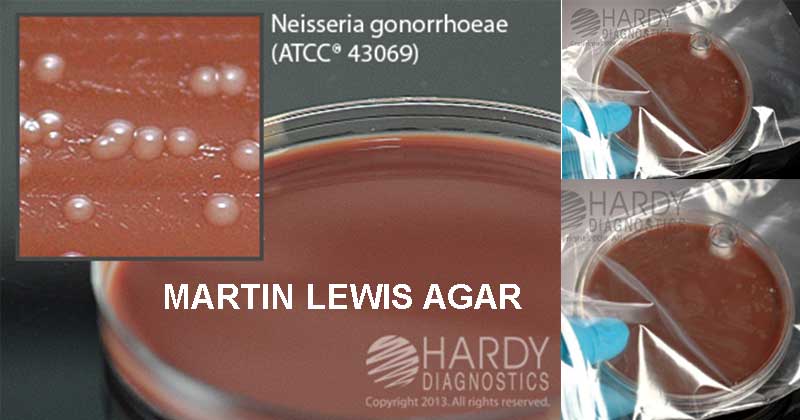Thayer-Martin Agar was developed in 1964 for the isolation of N. gonorrhoeae and N. meningitidis. A further modification of these early formulations was developed to improve the isolation of pathogenic Neisseria sp. from specimens, which contained large amounts of mixed microbial flora.
Martin-Lewis Agar is the formulation made after modification that contains an increased level of vancomycin for greater inhibition of gram-positive organisms. The development of the Martin-Lewis (ML) medium represents a more recent modification in the original Thayer-Martin formulation which has resulted in the enhanced recovery of gonococci from clinical material. Martin Lewis Agar is a selective and enriched medium for the isolation and cultivation of Neisseria species from mixed flora. Hemoglobin, Bio-X, and dextrose incorporated in the culture media provide enough nutrient agents to permit luxuriant growth of fastidious microorganisms.
Interesting Science Videos
Composition of Martin Lewis Agar
| Ingredients | Gms/L |
| Casein Peptone | 7.5 |
| Meat Peptone | 7.5 |
| Corn Starch | 1.0 |
| Potassium Phosphate, dibasic | 4.0 |
| Potassium Phosphate, monobasic | 1.0 |
| Sodium Chloride | 5.0 |
| Agar | 10.0 |
| Hemoglobin | 10.0 |
| Dextrose | 1.5 |
| Enrichment Bio-X | 10 ml |
| Antibiotics V.C.A.T | 10 ml |
pH 7.2 +/- 0.2 at 25º C
Enrichment Bio-X
| Purified Water Vitamin B12 | 0.01 g |
| Thiamine Pyrophosphate | 0.1 g |
| L-Glutamine | 10.0 g |
| Ferric Nitrate | 0.02 g |
| Adenine | 1.0 g |
| Thiamine Hydrochloride | 0.003 g |
| Guanine Hydrochloride | 0.03 g |
| L-Cysteine Hydrochloride | 25.9 g |
| p-Aminobenzoic Acid | 0.013 g |
| L Cystine | 1.1 g |
| Nicotinamide Adenine Dinucleotide | 0.25 g |
| Dextrose | 100.0 g |
Principle of Martin Lewis Agar
Martin Lewis Agar consists of a chocolate agar base which contains an improved GC Agar base, bovine hemoglobin, and a chemically defined enrichment. The GC base provides nitrogenous nutrients, in the form of casein and meat peptones, phosphate buffer to maintain pH, and cornstarch to neutralize toxic fatty acids that may be present in the agar. Hemoglobin provides X factor (hemin). Chemically defined enrichments, Bio-X enrichment, provide V factor (nicotinamide adenine dinucleotide – NAD), vitamins, amino acids, coenzymes, dextrose, ferric ions, and other growth factors necessary for improvement and optimal growth of pathogenic Neisseria species. The selective medium comprises the antimicrobial agents vancomycin, colistin, anisomycin (V-C-A Inhibitor) and trimethoprim, to suppress the normal flora. Vancomycin is active primarily against gram-positive bacteria. Colistin inhibits gram-negative bacteria, including Pseudomonas species. Anisomycin inhibits yeasts and Trimethoprim inhibits Proteus.
Preparation of Martin Lewis Agar
- Suspend 36 g of dehydrated media in 500 ml of purified filtered water.
- Heat with frequent agitation and boil for one minute.
- Sterilize at 121º C for 15 minutes.
- Cool to 45-50º C.
- Add 500 ml of sterile 2% Hemoglobin, 10 ml of Bio-X Enrichment and 10 ml of V.C.A.T.
- Mix gently and dispense into sterile Petri dishes.
Result on Martin Lewis Agar

Image Source: Hardy Diagnostics
Typical colonial morphology on Martin-Lewis Agar:
Neisseria gonorrhoeae: Small grayish-white to colorless, mucoid colonies.
Neisseria meningitidis: Medium to large, blue-gray, mucoid colonies.
Uses of Martin Lewis Agar
- Martin-Lewis Agar is an enriched medium for the selective isolation of Neisseria species.
- Martin Lewis with Lincomycin provides a rich, selective growth media with decreased vancomycin for the recovery of Neisseria gonorrhoeae from both genital and oropharyngeal specimens.
Limitations of Martin Lewis Agar
- Additional testing such as morphological, biochemical, and/or serological tests should be performed for final identification to confirm the findings.
- N. gonorrhoeae, are fastidious organisms that exhibit sensitivity to desiccation and temperature extremes. The ability to detect microorganisms by culture techniques can be affected by the following factors: improper specimen collection, storage and inoculation, initiation of anti-infective therapy prior to specimen collection, improper culture incubation temperatures and atmospheres, improper length of culture incubation and improper material, over storage and handling of culture media storage and handling of culture media.
- Some strains of N. gonorrhoeae may be inhibited by vancomycin and some by trimethoprim lactate.
- Certain oxidase-positive, gram-negative bacilli will grow on selective media and produce colonies resembling N. gonorrhoeae.
References
- Quelab
- Becton, Dickinson and Company
- Health link
- Granato P, Paepke JL and Weiner LB (1980). Comparison of Modified New York City Medium with MartinLewis Medium for Recovery of Neisseria gonorrhoeae from Clinical Specimens. Journal of Clinical Microbiology 12(6): 748-752.
- Ronald M. Atlas and James W. Snyder (2014). Handbook of media for clinical and public health microbiology. CRC Press. Taylor & Francis Group, LLC.

Thank you so much for this Articel! Very helpful for my Bachelor Thesis 🙂